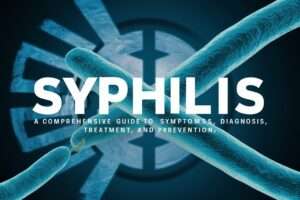Syphilis: A Comprehensive Guide to Symptoms, Diagnosis, Treatment, and Prevention
Syphilis is a sexually transmitted infection (STI) that has been around for centuries, yet it continues to be a significant public health concern worldwide. This comprehensive guide will delve into the intricacies of syphilis, covering everything from its causes and symptoms to diagnosis, treatment, and prevention strategies. Whether you’re concerned about your own health or simply want to be better informed, this article will provide you with the knowledge you need to understand and protect against this ancient yet persistent disease.
Butyric Acid: The Gut-Friendly Compound You Need to Know About

Table of Contents
ToggleWhat is Syphilis?
Syphilis is a bacterial infection caused by Treponema pallidum. This spiral-shaped bacterium is incredibly small and can only be seen under a microscope. Syphilis is primarily transmitted through sexual contact, including vaginal, anal, and oral sex. It can also be passed from mother to child during pregnancy or childbirth, a condition known as congenital syphilis.
Syphilis Testing: A Comprehensive Guide to Diagnosis and Screening

The Global Impact of Syphilis
According to the World Health Organization (WHO), there were an estimated 6 million new cases of syphilis among adults aged 15-49 years in 2016. The Centers for Disease Control and Prevention (CDC) reported that in the United States, there were 129,813 new cases of syphilis in 2019, marking a 70% increase since 2015. These statistics highlight the ongoing relevance of syphilis as a public health issue.
Stages of Syphilis
One of the most crucial aspects of understanding syphilis is recognizing its different stages. The infection progresses through four distinct phases, each with its own set of symptoms and characteristics:
Oral Gonorrhea: A Comprehensive Guide to Symptoms, Diagnosis and Treatment

1. Primary Syphilis
The primary stage typically occurs 3 to 90 days after infection. The hallmark symptom of this stage is the appearance of one or more chancres. These are small, painless sores that appear at the site where the bacteria entered the body, usually on the genitals, anus, or mouth.
Key characteristics of primary syphilis:
– Chancres are typically round, firm, and painless
– They last 3 to 6 weeks and heal on their own
– The presence of a chancre makes it easier to transmit or contract HIV
Hepatitis A, B, and C: Understanding the Differences and Similarities
2. Secondary Syphilis
If left untreated, the infection progresses to the secondary stage, which can start while the chancre is healing or several weeks after it has healed. This stage is characterized by skin rashes and mucous membrane lesions.

Symptoms of secondary syphilis include:
– Skin rash, often on the palms of hands and soles of feet
– Fever
– Swollen lymph glands
– Sore throat
– Patchy hair loss
– Headaches and muscle aches
– Fatigue
– Weight loss
These symptoms will resolve on their own, even without treatment, typically within a few weeks or months.
3. Latent Syphilis
The latent stage begins when the symptoms of secondary syphilis disappear. During this stage, there are no visible signs or symptoms of syphilis, but the infection remains in the body. The latent stage can last for years.
This stage is divided into two phases:
– Early latent syphilis: The first year of the latent stage
– Late latent syphilis: After the first year of the latent stage
It’s important to note that individuals are still infectious during the early latent phase.
Understanding Hepatitis B: Transmission, Prevention and Treatment
4. Tertiary Syphilis
If syphilis remains untreated, it may progress to the tertiary stage. This occurs in approximately 15-30% of untreated individuals and can happen anywhere from 10 to 30 years after the initial infection.
Tertiary syphilis can affect multiple organ systems, including:
– The heart and blood vessels
– The brain and nervous system (neurosyphilis)
– The eyes (ocular syphilis)
– Liver, bones, and joints
Complications of tertiary syphilis can be severe and even life-threatening, emphasizing the importance of early detection and treatment.
Diagnosis of Syphilis
Diagnosing syphilis involves a combination of physical examination and laboratory tests. The most common diagnostic methods include:
1. Blood Tests
– Nontreponemal tests: VDRL (Venereal Disease Research Laboratory) and RPR (Rapid Plasma Reagin) tests
– Treponemal tests: FTA-ABS (Fluorescent Treponemal Antibody Absorption) and TPPA (Treponema Pallidum Particle Agglutination) tests
2. Darkfield Microscopy
This method involves examining fluid from a chancre under a microscope to detect the presence of T. pallidum bacteria.
3. Cerebrospinal Fluid (CSF) Analysis
This is performed if neurosyphilis is suspected.
Treatment Options for Syphilis
The good news is that syphilis is curable with appropriate antibiotic treatment. The type and duration of treatment depend on the stage of the infection and the patient’s overall health status.
1. Early Syphilis (Primary, Secondary, and Early Latent)
– Single intramuscular injection of long-acting Benzathine penicillin G
2. Late Latent Syphilis or Tertiary Syphilis
– Three doses of Benzathine penicillin G given at weekly intervals
3. Neurosyphilis
– Intravenous penicillin G for 10 to 14 days
For individuals allergic to penicillin, alternative antibiotics such as doxycycline or tetracycline may be prescribed. However, these alternatives are not recommended for pregnant women or for treating neurosyphilis.
It’s crucial to complete the entire course of antibiotics as prescribed by your healthcare provider. Additionally, follow-up blood tests are necessary to ensure that the infection has been successfully treated.
Prevention Strategies
Preventing syphilis involves a combination of safe sex practices and regular testing:
1. Practice Safe Sex
– Use condoms consistently and correctly during all sexual activities
– Limit the number of sexual partners
– Engage in open communication with partners about STI history and testing
2. Regular Testing
– The CDC recommends annual syphilis screening for individuals at increased risk, including men who have sex with men and people living with HIV
3. Prenatal Screening
– All pregnant women should be tested for syphilis at their first prenatal visit
4. Partner Notification
– If diagnosed with syphilis, inform all recent sexual partners so they can get tested and treated if necessary
5. Abstinence
– The only 100% effective method of prevention is abstaining from sexual activity
Syphilis and HIV
It’s worth noting that there’s a significant interplay between syphilis and HIV. Having syphilis can increase the risk of contracting HIV by two to five times. Conversely, HIV can alter the progression and presentation of syphilis, making diagnosis and treatment more challenging. For this reason, individuals diagnosed with syphilis should also be tested for HIV and vice versa.
Congenital Syphilis: A Growing Concern
Congenital syphilis occurs when a mother passes the infection to her baby during pregnancy or childbirth. This can lead to severe health problems for the baby, including:
– Stillbirth or early infant death
– Low birth weight
– Bone deformities
– Severe anemia
– Enlarged liver and spleen
– Jaundice
– Brain and nerve problems, including blindness or deafness
The CDC reported a 185% increase in congenital syphilis cases from 2014 to 2018, highlighting the importance of prenatal syphilis screening and treatment.
Conclusion
Syphilis, despite being an ancient disease, remains a significant public health concern in the 21st century. Its ability to mimic other diseases, coupled with periods of latency, makes it a challenging infection to diagnose and control. However, with proper education, regular testing, and prompt treatment, we can effectively manage and prevent the spread of this infection.
Remember, if you suspect you may have been exposed to syphilis or any other STI, don’t hesitate to seek medical attention. Early detection and treatment are key to preventing serious health complications and stopping the spread of the infection. Stay informed, practice safe sex, and prioritize your sexual health – your body will thank you for it.
Reference to External Sources:
1. Centers for Disease Control and Prevention (CDC) – Syphilis:
2. World Health Organization (WHO) – Syphilis:
3. National Health Service (NHS) UK – Syphilis:
4. American Sexual Health Association – Syphilis:
5. Mayo Clinic – Syphilis:


